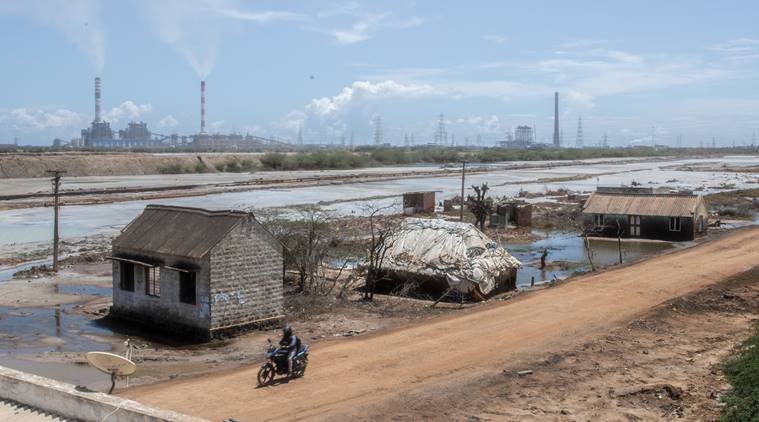 Abandoned homes of families forced to relocate due to coal ash pollution stand flooded by ash slurry in Sepakkam, Ennore, Tamilnadu. (Source: Ishan Tankha, Clean Air Collective)
Abandoned homes of families forced to relocate due to coal ash pollution stand flooded by ash slurry in Sepakkam, Ennore, Tamilnadu. (Source: Ishan Tankha, Clean Air Collective)
There have been 76 major coal ash pond accidents across the country in the last 10 years, according to a study carried out by the Health Energy Initiative India and the Community Environmental Monitoring.
Besides deaths and loss of property, the accidents also resulted in extensive pollution of nearby water resources, air and soil, the study notes.
The study, titled “Coal Ash in India – A compendium of Disasters, Environmental and Health Risks”, reports that Jharsusguda in Odisha has had six major coal fly-ash accidents from various power plants since 2010. Among other places in Odisha, it states Sambalpur has had four such accidents, Talcher three, Rourkela, Angul, Dhenkanal and Khaliapali have had one accident each.
Korba coal and power plant belt in Chhattisgarh has had nine major accidents in these years, and Raigarh in the state three.
Other states where such accidents have taken place are Karnataka, Andhra Pradesh, Madhya Pradesh, Maharasthra, West Bengal, Jharkhand, Tamil Nadu and Punjab.
Coal ash is fine grained particulate matter – a remnant after pulverised coal is burnt, along with carbon dioxide and other gases. Coal ash includes fly-ash, bottom-ash and scrubber sludge, which are mixed with water and sent to retaining ponds close to power plants.
While the study details major accidents, it says there are many “routine” minor accidents take place continually in these coal and power plant belts.
Shweta Narayan, coordinator of Healthy Energy Initiative India, said: “While mining and coal burning have received their fair share of attention, dangers of coal ash, and the impacts of its disposal, are still under the radar. Public outrage associated with coal ash pollution remains limited to big disasters. The slow poisoning of communities living around ash containment ponds goes unnoticed.”
In 2000, the Centre shifted classification of fly-ash was from the category of “hazardous industrial waste” to that of “waste material”. But the report notes that the Environment Ministry did not provide any supporting health-based scientific rationale on why this categorisation was changed.
Washing of coal before burning was earlier mandatory to reduce ash content, and notifications for this were passed in 1997, 1998 and 1999. The government subsequently issued a gazetted notification in 2014 making coal washing mandatory for supply to all thermal units more than 500 km from a coal mine, the report notes.
But in May this year, the Ministry of Environment Forest and Climate Change made coal washing optional through an amendment after recommendations made by Niti Aayog and Power and Coal ministries.
On the risks associated, the report states: “Coal ash is known to contain toxic chemicals like arsenic, aluminum, antimony, barium, cadmium, selenium, nickel, lead and molybdenum, among other carcinogens. Along with increased risk of cancers from toxic heavy metal exposure, coal ash can affect human development, create lung and heart problems, cause stomach ailments, and contribute to premature mortality.”
Health studies conducted among communities living close to coal mines and coal ash ponds in Chhattisgarh have shown increased incidences of chronic health conditions, it notes.